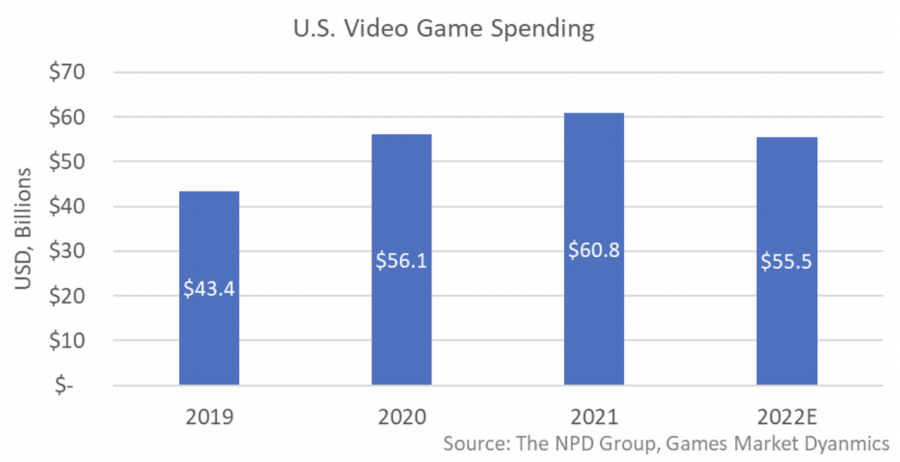Sales Drop, Playing Hours Rise
During the pandemic that started in early 2020, the popularity of video games skyrocketed, primarily because people were stuck at home. Today, statistics show that post-pandemic video gaming sales are on the decline, but the average number of hours played by the average American gamer is climbing.
This year, the average hours a video consumer spent playing video games per week came to 16.5 in the United States, according to industry estimates. In comparison, at the peak of the pandemic, the average was 14.8 hours per week.
Students at Warren Hills seem to buck this trend. Anecdotally, they have reported that their gaming hours have remained steady or declined in post-pandemic times.
Freshman Matthew Cruz, for example, said he still plays “probably eight hours” of video games each day, which is the same amount he had played during the COVID-19 shutdown.
“Nothing changed,” Cruz said. He believes that other gamers, including his friends, are gaming fewer hours today “because they aren’t stuck at home.”
Surprisingly, the recent increase in average individual gaming activity is accompanied by a dip in gaming companies’ revenue.
Video game sales amounted to $56.9 billion in the United States in 2020, according to statistics compiled by Bentley University, a private business school in Massachusetts.
That dollar amount rose even more in 2021, with around $60.4 billion in sales, according to PR Newswire, which added that around 82 percent of people around the world played or watched video games during the peak of the pandemic.
The increase in interest in online video games became insane when millions of people sought entertainment because everyone was stuck at home. Online video games also allowed people to communicate and socialize with each other. Gamers considered interactive video games a way to reduce boredom and to improve their mental health.
Now, with the COVID-19 pandemic mostly over, everyone is able to hang out outside, meet their friends, go shopping and to restaurants, etc., so people seem to have lost interest in gaming in general. Others may not have the time for video gaming, since schools and jobs are back open.
“Less,” Warren Hills freshman Jordan Gaines said when asked if he was playing video games more or less often today. “Since the pandemic’s gone down, there’s now time to hang out with friends. Now there’s not enough time” to play video games.
Industry statistics indicate that gaming is slowly declining.
Websites like Reuters and Itechpost report that the number of video-game consumers in the United States dropped by 11 percent in the past year. Video game sales for Activision Blizzard, an American video-game holding company that trades on the NASDAQ stock exchange, have gone down by half. Sony reported that its sales decreased by 2 percent and its earnings plummeted by 37 percent. Microsoft’s revenue decreased by 7 percent, and Xbox’s sales went down 6 percent.
Gaming companies are feeling the effects of the post-pandemic. Their immense increase in revenue and sales seems to be going back to its regular growth.
This can seem bad when looking at the statistics, but the gaming industry may still be thriving. A well-respected website called Statista says there are still around 3.03 billion people playing video games worldwide, and the industry pulls in around $197 billion in annual revenue.











